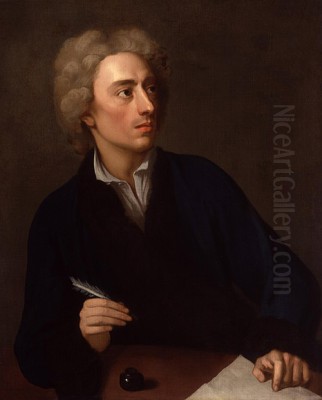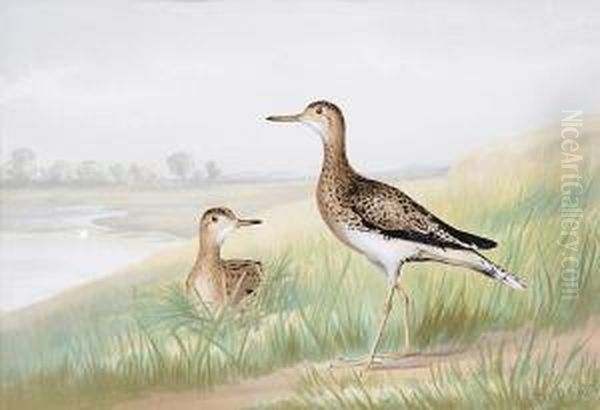
Alexander Pope, Jr. stands as a notable figure in American art during the late nineteenth and early twentieth centuries. Born in 1849 and passing away in 1924, Pope carved a distinct niche for himself, primarily celebrated for his detailed depictions of wildlife, hunting scenes, and his mastery of the trompe l'oeil technique. Active predominantly in Boston, Massachusetts, his work encompassed painting, sculpture, and printmaking, reflecting both a deep appreciation for the natural world and a sophisticated understanding of artistic craft. His contributions offer a fascinating window into the artistic currents and cultural interests of his time.
Early Life and Artistic Formation
Alexander Pope was born in Dorchester, then a town near Boston, Massachusetts, in 1849. From an early age, he reportedly displayed a natural inclination towards art, spending time sketching and carving animals. This innate talent found practical application during the 1860s when Pope worked for his family's lumber business. This period likely provided him with invaluable hands-on experience with wood, honing the carving skills that would later manifest in his sculptures and potentially influencing his understanding of form and texture, crucial elements in his later paintings.
A pivotal moment in Pope's artistic development came when he sought formal training under the tutelage of Dr. William Rimmer. Rimmer was himself a significant, if somewhat eccentric, figure in American art – a respected sculptor, painter, and anatomist known for his dramatic, often Michelangelesque style, sometimes described as Romantic Baroque. Studying with Rimmer provided Pope with a rigorous foundation in essential artistic disciplines: carving, painting, perspective, and, crucially, anatomy. Rimmer's emphasis on anatomical accuracy undoubtedly informed Pope's later ability to render animals with convincing realism and vitality. This training occurred within the burgeoning artistic environment of Boston, a city cultivating its own distinct cultural identity.
Launching an Artistic Career
Having gained foundational skills and likely encouraged by his early efforts, Alexander Pope transitioned to pursuing art professionally in the late 1870s. His initial recognition came not primarily through painting, but through his skillful wood carvings. Between 1879 and 1883, Pope created numerous carved wooden pieces, often depicting animals, which gained considerable popularity. These works were noted for their lifelike quality and craftsmanship.

The appeal of these early sculptures extended beyond local appreciation. Remarkably, some of Pope's wood carvings attracted international attention, finding their way into the collection of Tsar Alexander III of Russia. This imperial acquisition serves as a significant testament to the quality and appeal of Pope's sculptural work during this formative period of his career, signaling his arrival as an artist of note even before he fully dedicated himself to painting. This early success in sculpture provided a foundation of recognition upon which he would build his subsequent career.
Mastery of Trompe l'Oeil
While skilled in sculpture, Alexander Pope became particularly renowned in Boston art circles for his work in the style known as trompe l'oeil, a French term meaning "deceive the eye." This genre of still life painting aims to create illusions so convincing that the viewer momentarily mistakes the depicted objects for real ones. Pope embraced this technique with enthusiasm, applying it primarily to subjects related to his personal interests: hunting and fishing. His trompe l'oeil paintings often featured arrangements of game birds, fishing tackle, hunting gear, and other related paraphernalia, rendered with meticulous detail against a shallow, often wood-textured background.
Pope's skill in this demanding genre placed him among the notable American practitioners of trompe l'oeil during its period of popularity in the late 19th century. He worked contemporaneously with the acknowledged master of the style, William Michael Harnett, whose intricate depictions of everyday objects set a high standard. While perhaps not achieving the same level of widespread fame as Harnett, Pope developed a strong reputation for his own contributions. Other artists exploring similar illusionistic territory during this era included John Frederick Peto and John Haberle, each bringing their unique sensibilities to the challenge of visual deception. Pope's work in this style combined technical virtuosity with his passion for outdoor subjects.
Themes of Nature and Sporting Life
A defining characteristic of Alexander Pope's oeuvre is its consistent focus on themes drawn from nature, particularly wildlife and the sporting life. His canvases and sculptures frequently feature animals, ranging from domestic dogs to game birds and waterfowl. Hunting and fishing scenes, along with still lifes composed of the "trophies" of the hunt, were recurrent subjects. These themes were not merely artistic choices but stemmed from Pope's own experiences and appreciation for the outdoors, lending an air of authenticity to his work. He was, in many respects, a chronicler of the pursuits and interests of a segment of American society deeply connected to nature.
His dedication to these subjects is further evidenced by the publication of two significant sets of lithographs. Upland Game Birds and Water Fowl of the United States and Celebrated Dogs of America showcased his detailed renderings of fauna to a wider audience. These publications solidified his reputation as an expert in animal depiction. His focus on American wildlife can be seen in the broader context of artists like Winslow Homer, who also depicted scenes of hunting and fishing in the American wilderness, albeit with a very different, more narrative and less hyper-realistic style. Pope's detailed realism, however, set his work apart.
Artistic Style and Technique
Alexander Pope's artistic style is primarily characterized by realism, particularly evident in his meticulous attention to detail in rendering textures like feathers, fur, wood grain, and metal. This precision was essential for the success of his trompe l'oeil works but also defined his animal portraits and other still lifes. His training under William Rimmer, with its emphasis on anatomy, provided the structural understanding necessary for depicting animals with convincing form and posture. While sometimes associated with Romanticism, likely due to the era and perhaps a certain idealization of nature, the dominant mode in his finished works appears to be a highly polished realism.
His technique involved careful brushwork to achieve smooth surfaces and subtle gradations of tone. Sources mention his unique use of light, shadow, and color, suggesting a sophisticated handling of chiaroscuro to enhance the illusion of three-dimensionality and highlight the textures of his subjects. This contrasts sharply with the broader, more atmospheric approaches of landscape contemporaries like George Inness or Albert Bierstadt, or the emerging Impressionistic tendencies seen in the work of some Boston School painters like Frank Weston Benson and Edmund Charles Tarbell. Pope remained dedicated to a precise, descriptive mode of representation, aligning him more closely with the realist traditions exemplified by artists like Thomas Eakins, though focused on different subject matter.
Later Career and Recognition
From 1893 onwards, Alexander Pope began to dedicate more of his artistic energy to portraiture, alongside his continued work with animal and still life subjects. He remained an active figure in the Boston art scene until his death in 1924. His commitment to his craft and his established reputation earned him recognition within the artistic community. He held memberships in prominent local organizations, including the Boston Art Club and the Copley Society of Art (then known as the Boston Society of Water Color Painters, later evolving into the Copley Society). These affiliations indicate his standing among his peers.
The enduring quality of Pope's work is reflected in its presence in significant public collections. His paintings and sculptures can be found in institutions such as the Metropolitan Museum of Art in New York, the White House collection in Washington D.C., and the National Museum of Wildlife Art in Jackson, Wyoming. The inclusion of his work in these collections underscores his contribution to American art history, particularly within the genres of animal painting, sporting art, and trompe l'oeil still life. His dedication to still life finds resonance with the work of contemporaries like Emil Carlsen, although Carlsen often pursued a more tonalist or impressionistic aesthetic in his arrangements.
Legacy and Conclusion
Alexander Pope occupies a specific and respected place in the history of American art from the late 19th and early 20th centuries. He was a versatile artist, proficient in both painting and sculpture, who distinguished himself through his commitment to realism and his exceptional skill in the demanding technique of trompe l'oeil. His body of work serves as a valuable record of American wildlife and the culture of sporting life during his era, rendered with anatomical accuracy and meticulous attention to detail.
While perhaps overshadowed in broader art historical narratives by innovators of modernism or landscapists of the sublime, Pope excelled within his chosen genres. His association with William Rimmer connects him to an important lineage of anatomical study in American art, and his work stands alongside that of William Michael Harnett and John F. Peto in the fascinating chapter of American trompe l'oeil painting. His depictions of animals also place him in the company of other artists focused on fauna, such as the sculptors of the American West, Frederic Remington and Charles Marion Russell, though Pope's context remained firmly rooted in the East Coast. Through his dedication, skill, and focused subject matter, Alexander Pope made a lasting contribution, leaving behind works that continue to engage viewers with their illusionistic charm and celebration of the natural world.